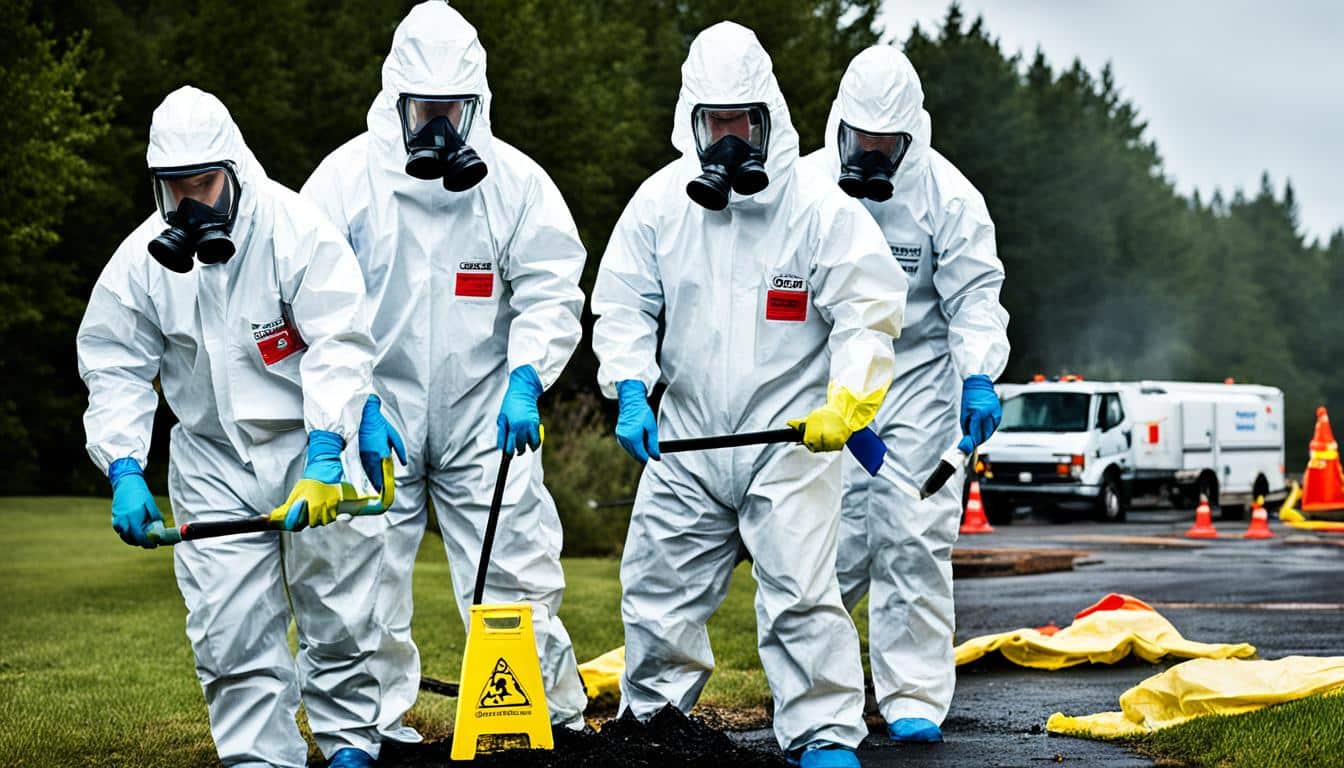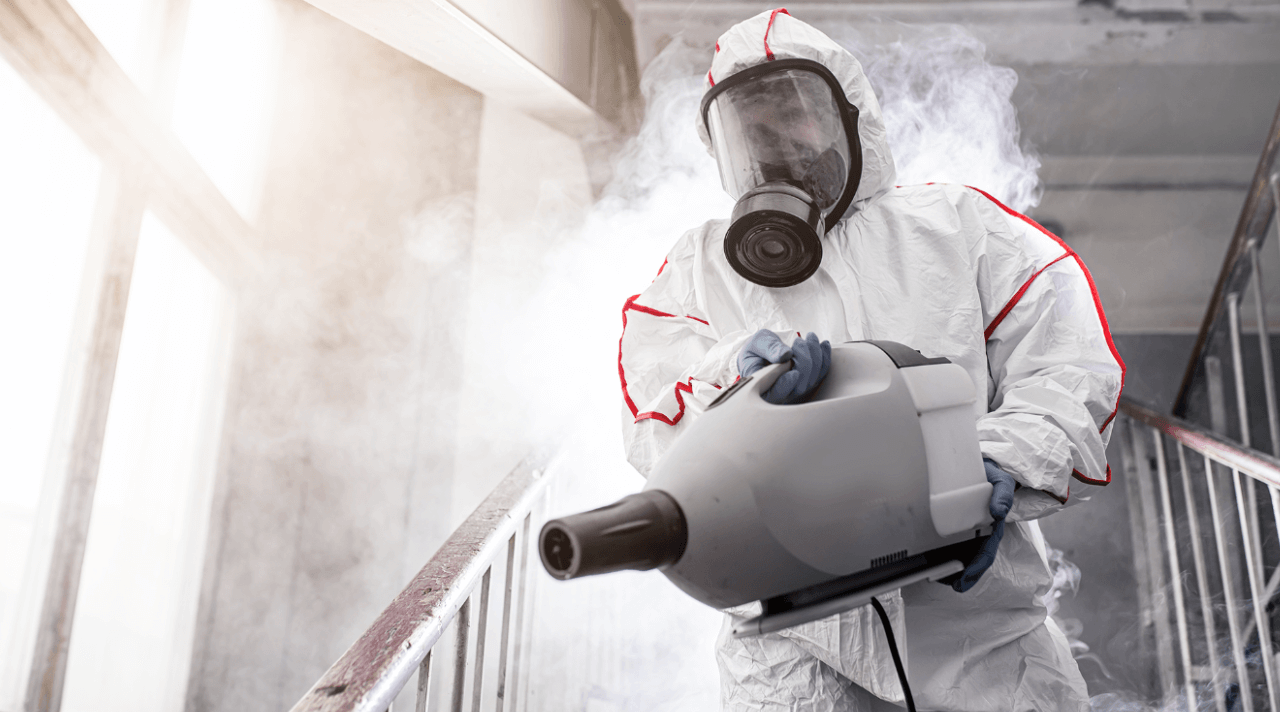Clandestine Lab Cleanup: Comprehensive Purification for Hazardous Sites
Wiki Article
Professional Biohazard Cleansing and Decontamination for Blood, Bodily Fluids, and Hazardous Materials
The prospective wellness threats linked with exposure to biohazards emphasize the crucial demand for precise handling and thorough clean-up. As we navigate the elaborate landscape of biohazard cleanup, comprehending the nuances of laws, compliance, and the specific equipment at play comes to be vital in guaranteeing a extensive and safe purification process.
Health Dangers of Biohazard Direct Exposure
Exposure to biohazards positions substantial health dangers that can cause severe effects for neighborhoods and people alike. Biohazards encompass a vast array of organic substances, including blood, bodily fluids, mold and mildew, bacteria, viruses, and other possibly contagious products. When individuals come right into contact with these biohazards, whether with crashes, incorrect handling, or ecological exposure, they deal with the danger of having serious ailments or conditions.Among the primary health threats associated with biohazard exposure is the transmission of contagious conditions. Bloodborne pathogens such as HIV, hepatitis B and C, and numerous bacteria can be existing in biohazardous products, posing a direct risk to human health. Inhaling airborne biohazards like mold spores or entering into contact with infected surfaces can also result in breathing problems, allergies, and various other adverse health and wellness results.
Additionally, biohazard direct exposure can have lasting health and wellness ramifications, with some conditions showing up years after the first get in touch with (Blood Cleanup). As a result, it is crucial to prioritize appropriate biohazard cleaning and decontamination to mitigate these health dangers and make sure the security of areas and people

Specialized Educating for Biohazard Cleaning
When it pertains to taking care of biohazard cleaning effectively and safely, specialized training plays a fundamental duty in ensuring correct decontamination treatments are adhered to. Biohazard cleaning calls for specific understanding and abilities to successfully minimize threats connected with bloodborne virus, physical fluids, and hazardous materials. Professionals learnt biohazard cleaning undergo extensive guideline on just how to securely take care of, remove, and take care of biohazardous products to stop contamination and exposure.Specialized training for biohazard cleanup covers a variety of crucial subjects, including correct individual safety tools (PPE) usage, bloodborne pathogen awareness, decontamination strategies, and contaminated materials disposal procedures. Individuals learnt biohazard clean-up are geared up with the necessary proficiency to examine contamination degrees, determine potential hazards, and apply appropriate clean-up procedures in compliance with regulatory requirements.
Constant training and education and learning are paramount in the area of biohazard cleaning to stay updated on the most current purification modern technologies, security procedures, and policies. By buying specialized training, biohazard cleanup experts can effectively reply to emergency situation cleaning scenarios and secure both public health and the environment.
Relevance of Proper Purification Techniques
Utilizing proper decontamination strategies is crucial in biohazard cleanup to effectively get rid of hazardous materials and reduce health and wellness risks. Reliable decontamination not only makes sure the removal of visible traces of blood, physical fluids, and various other biohazards yet additionally targets unseen pathogens that might pose severe health hazards if not appropriately eradicated. By adhering to rigorous purification procedures, educated professionals can substantially minimize the danger of exposure to unsafe microorganisms, viruses, and bacteria that can lead to infections or illness.Appropriate decontamination strategies entail making use of specialized equipment and disinfectants that are particularly developed to counteract biohazards efficiently. Comprehensive cleaning and disinfection of infected locations are important to avoid the spread of virus and ensure a secure environment for residents. Furthermore, the correct disposal of biohazardous waste following decontamination treatments is essential in stopping contamination of other surface areas or individuals.

Equipment and Devices for Safe Clean-up
When dealing with blood, bodily fluids, or unsafe products, biohazard cleansing specialists rely on specialized equipment to minimize direct exposure dangers and thoroughly decontaminate the damaged location. In addition, biohazard cleaning kits including disinfectants, absorbent products, and biohazard bags are made use of to securely consist of and dispose of infected items.Advanced cleansing devices like hospital-grade anti-bacterials, HEPA-filtered vacuum cleaners, and fogging machines are employed to sterilize surface areas and eliminate biohazards successfully. Specialized tools such as sharps containers and biohazard waste disposal bins are made use of to securely handle sharp objects and biohazardous waste materials. By making use of the ideal equipment and tools, biohazard cleaning professionals can make certain a detailed clean-up procedure that prioritizes safety and reduces wellness dangers for both workers and occupants of the damaged area.
Laws and Conformity in Biohazard Cleaning
Proper adherence to guidelines and conformity requirements is paramount in biohazard cleaning to make certain the safety of both employees and the atmosphere. Federal government firms such as OSHA (Occupational Safety and Wellness Management) and the EPA (Environmental Security Firm) have actually established certain standards for biohazard cleaning procedures to lessen wellness threats and environmental contamination. These guidelines cover a variety of facets including the handling, transportation, and disposal of biohazardous products, along with the essential training and safety tools needed for workers associated with the cleaning procedure.Biohazard cleaning companies must stay current with these policies to guarantee that their operations satisfy the required safety and security standards. Failure to follow these regulations can result in serious effects, consisting of penalties, lawful activity, and endangering the wellness of people and the setting. By adhering to strict regulations and conformity actions, biohazard cleaning firms can successfully reduce risks and ensure a comprehensive and safe clean-up procedure for all celebrations involved.
Final Thought
To conclude, biohazard cleansing and purification call for customized training, proper methods, and adherence to laws. Direct exposure to blood, bodily liquids, and hazardous products positions substantial health and wellness risks, making it crucial to use the best equipment and devices for risk-free clean-up. By complying with stringent protocols and standards, professionals can efficiently minimize the risks related to biohazard direct exposure and guarantee the security of both themselves and others.
As we navigate the complex landscape of biohazard cleanup, comprehending the nuances of policies, compliance, and the specialized devices at play comes to be vital in making sure a safe and extensive decontamination procedure. (Blood Cleanup)
When it comes to taking care of biohazard clean-up successfully and securely, specialized training plays an essential role in making sure proper decontamination procedures are complied with.Making use of correct decontamination strategies is important in biohazard cleaning to efficiently decrease and get rid of unsafe materials wellness dangers. In addition, biohazard cleaning kits including disinfectants, absorbing materials, and biohazard bags are made use of to securely dispose and include of polluted things.
Government companies such as OSHA (Occupational sewage cleanup Safety And Security and Wellness Administration) and the EPA (Environmental Defense Agency) have actually established particular guidelines for biohazard cleanup treatments to reduce wellness dangers and environmental contamination.
Report this wiki page